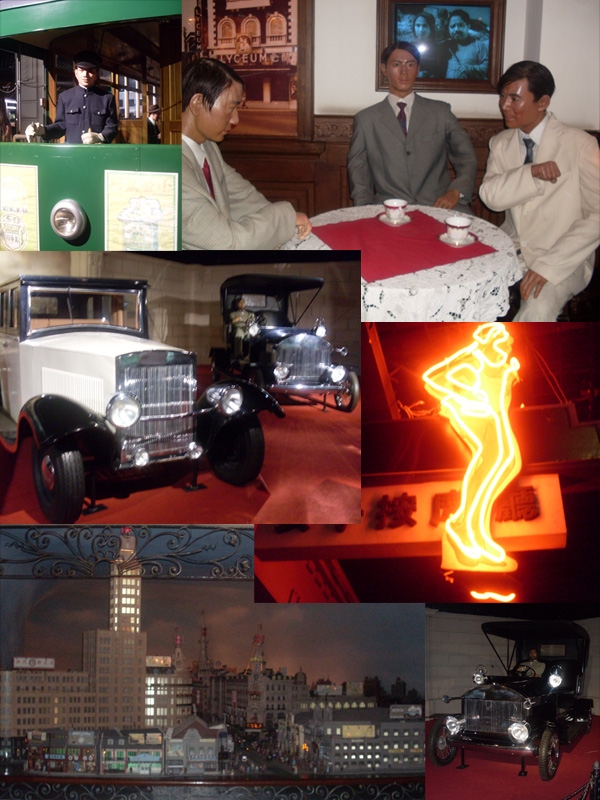Intermission #6 - Shanghai, China in the 1920s
Nicotine on July 22, 2011
(For comments about the Drunk Duck change over, ect. see the comments section. And some of you may have missed it, but I posted a new page *right* before the change over, so click back for it!)
Hello everyone!
As a lot of you may already know, I have been (and still am!) in China studying abroad. I will be here until August 8th.
Before I came to China, I was a little bummed because I thought that I wouldn't be able to update, but I wanted to share this with you because it relates to the time period of The Rose Killer.
A couple of weeks ago, I was in Shanghai (I'm now in Beijing) and I got the chance to visit the Oriental Pearl Tower, one of the world's largest television towers. It is located near the historical Bund district in the city (which looks amazing at night!). These pictures were taken in the Pearl Tower in the Shanghai city museum within it. The museum uses hundreds of wax models to depict the history of Shanghai.
Before I get to explaining the picture, I'll give you a very quick rundown of the history of Shanghai and the Bund. :D
After China's loss to Japan after the Sino-Japanese War, China was forced to agree to the Treaty of Shimonoseki (the “most unfair” treaty China signed). By signing the treaty, the Chinese had to give up a large amount of power and influence in a lot of their coastal areas, including Shanghai. After the Japanese moved in and exerted their influence in Shanghai, other major powers of the world (France, Britain) followed suit and built factories in the city. The large volume of Westerners was one of the major causes of the Bund's formation, which was an economic center for the Westerners.
Now to the photos!
1 (top left) - That wax-man is supposed to be a train conductor. Like many other major cities in the 1920's, people in Shanghai would travel city-to-city by train quite often.
2 (top right) - These dapper guys are well-off Chinese men. Of course, during the foreign economic boom in Shanghai and other major Chinese cities in the early 20th century, some Chinese native prospered as well. These men might have been business men or perhaps translators. Either way, they certainly are part of an elite group. Just look at those suits!
3 (middle left; bottom right) - Those sharp guys in the other picture may have had enough money to buy one of these 1920s and 1930s Ford vehicles. If they didn't have enough money, their Western counterparts may certainly have. This was from the transportation section of the museum across from the train. Nice and shiny, these cars are!
4 (middle right) - This sign was part of the recreated early 20th century red-light district of the museum. Signs like this lured men in to have a good time. ^_~ (obviously for a fee!)
5 (bottom left) - Nope, this is not a real scene from Shanghai's skyline, this is a mini-scale replication of Shanghai's 1920's skyline. Isn't it great?! Even back then, Shanghai was a busy bustling city.










Tantz_Aerine at 5:21AM, July 24, 2011
Very interesting photos!
Gunwallace at 4:19PM, July 23, 2011
Great photos. Yeah, the last few weeks have been really sour, and the taste just won't go away -- but it's good to know you'll be updating again soon-ish.
usedbooks at 4:02PM, July 23, 2011
That's cool. :) The site is still kinda renovating. They've been really responsive to getting things working. I'm sticking around. It'd be stupid hard to move 900+ pages somewhere else.
wildcard at 7:34AM, July 23, 2011
And yeah, glad you're sticking around :) I'm not 100% happy with a lot of the changes but I suppose again that it's the community which stops me from leaving.
wildcard at 7:32AM, July 23, 2011
Pretty cool, I'm always fascinated by fashion/design details of history like this!
Nicotine at 7:30AM, July 23, 2011
~Regarding the new site~ Honestly, I am highly unhappy with the change over, but I have decided not to move because a lot of my readers and the comics I support, read, and enjoy are here. However, I will probably be setting up at another site, and I may change this location to a mirror site. We'll see. I'm still in China, so I'm not in a comfortable position to make big decisions like that (I can't even draw and upload pages here! xD) but I just wanted to inform you that I'm still here. :D